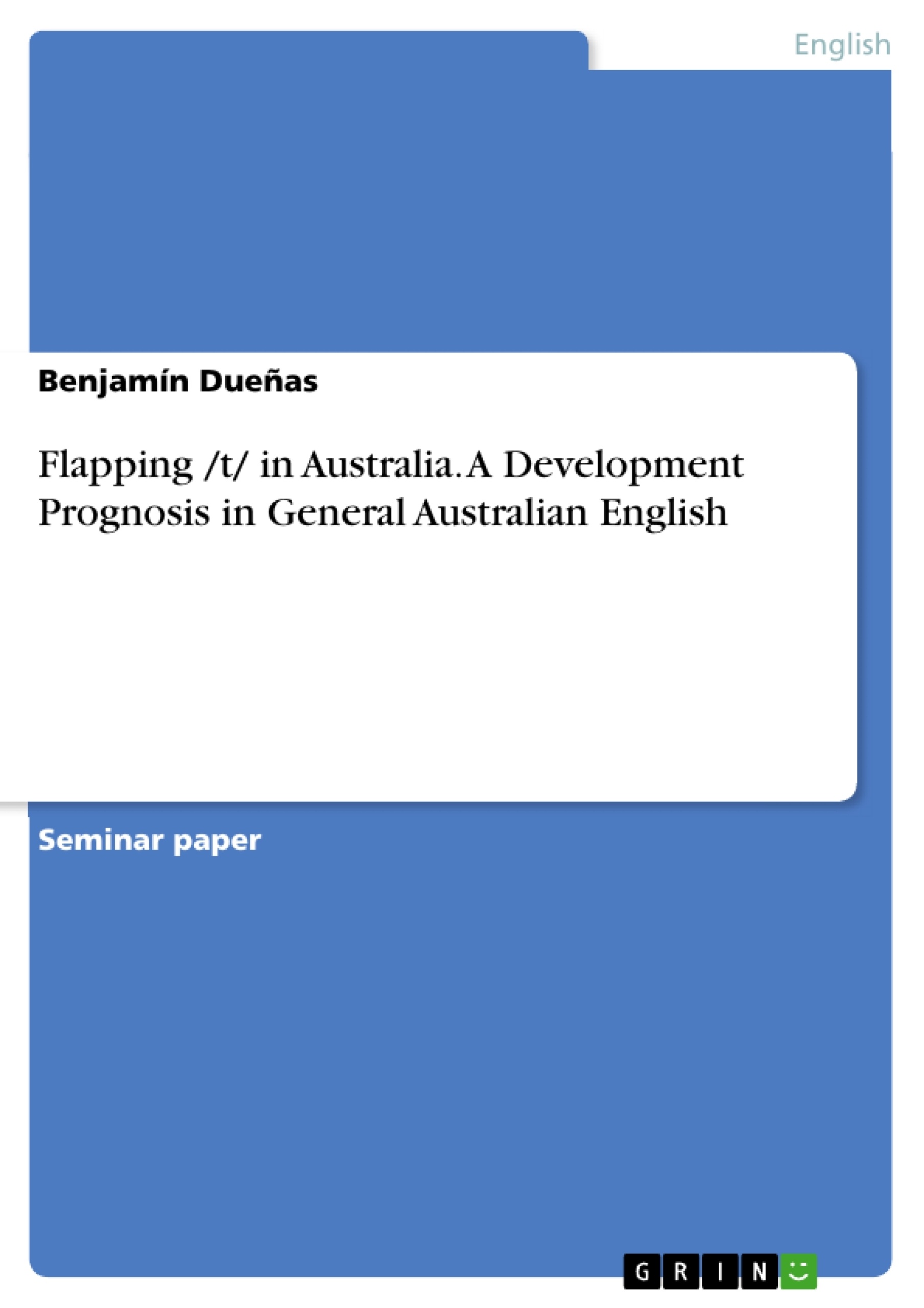This paper will study the flapping /t/ as it is today and its possible evolution in the nearer future in General Australian English. Australian English (AusE), as it is today, is an English accent that counts with own and also shared features when compared to other variants of English. One of the phenomena that can be encountered in AusE is the realization of a flapped or tapped /t/ allophone (Honeybone 3), a tap alveolar, which is a quality that can easily be perceived when hearing Australians speak. After thoroughly revising English linguistic books though, it is remarkable that few authors appoint this phonetical process to also being part of AusE, but rather of American or Irish English nature among others; some do actually talk about this phenomenon as being also present in English spoken in the southern hemisphere, but they usually don’t specify in which territories, which does not help the reader to find enough information about this specific subject when needed.
Furthermore, Some AusE linguists seem to ignore this phenomenon when writing their research papers. Opportunely, there are a few authors who do correlate this as also being an AusE feature. This being said, their investigation will be taken as a starting point for further research on this subject.
The study to follow will target to get enough information about the flapping /t/ in AusE, trying to focus as much as possible in General AusE, by pointing out what it is, how it emerged and what is the current status of the phenomenon, in order to later on be able to compare these pieces of information with an own research on the ongoing situation based on recordings, which will then lead us to answer to the main question of this paper: What possible development can we expect from the flapping /t/ phenomenon in Australia?
Inhaltsverzeichnis (Table of Contents)
- Introduction
- Theoretical framework
- The flapping /t/
- The flapping /t/ in Australia
- Emergence
- Current situation
- Methodology
- Data analysis
- The ideal candidates
- Presentation of the results
- Observations
- Prognosis
- Conclusion
Zielsetzung und Themenschwerpunkte (Objectives and Key Themes)
This paper aims to investigate the flapping /t/ phenomenon in Australian English (AusE), specifically focusing on General AusE, the most rapidly expanding category of the dialect. The paper examines the emergence and current status of the flapping /t/ in AusE, drawing comparisons with other English varieties. Ultimately, the paper seeks to answer the question of what possible development can be expected from the flapping /t/ phenomenon in Australia.
- The emergence and development of the flapping /t/ in Australian English
- Comparison of the flapping /t/ in AusE to other English varieties
- The current status of the flapping /t/ in AusE
- The possible future development of the flapping /t/ in Australia
- The influence of immigration, Aboriginal languages, and American English on AusE
Zusammenfassung der Kapitel (Chapter Summaries)
- Introduction: Introduces the flapping /t/ phenomenon in Australian English and its significance within the broader context of English language variation. The paper highlights the lack of comprehensive research on this topic, particularly within AusE. The study will focus on General AusE, the most rapidly expanding category of the dialect, and will examine the emergence and current status of the flapping /t/ in AusE.
- Theoretical framework: Defines the flapping /t/ as a linguistic phenomenon and discusses its realization in various English varieties, including American and Irish English. The section also examines the historical and social factors that may have contributed to the emergence of the flapping /t/ in Australia, including immigration patterns, the influence of Aboriginal languages, and the cultural exchange with the United States of America.
- The flapping /t/: This section provides a detailed explanation of the flapping /t/, its definition, and its phonetic properties. It discusses how the flapping /t/ is realized in various English accents, and its distinction from other realizations of the /t/ phoneme. The section concludes with a discussion of the rules governing the use of the flapping /t/ in Australian English.
- The flapping /t/ in Australia: This section explores the historical emergence of the flapping /t/ in Australia, examining possible sources such as the influence of Irish immigrants, Aboriginal languages, and American English. The section concludes by discussing the current status of the flapping /t/ in AusE, noting that its realization is consistent across different regions of Australia.
Schlüsselwörter (Keywords)
This study focuses on the flapping /t/ phenomenon in Australian English, analyzing its historical development, current status, and possible future evolution. Key terms and concepts include: flapping /t/, AusE, General AusE, phonetics, phonology, sociolinguistics, language variation, language contact, immigration, Aboriginal languages, American English, British English, and Received Pronunciation (RP).
- Quote paper
- Benjamín Dueñas (Author), 2015, Flapping /t/ in Australia. A Development Prognosis in General Australian English, Munich, GRIN Verlag, https://www.grin.com/document/312130



